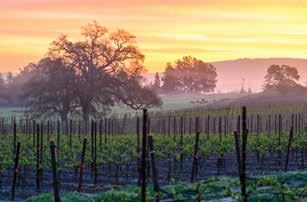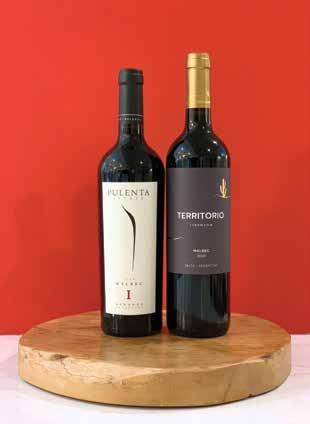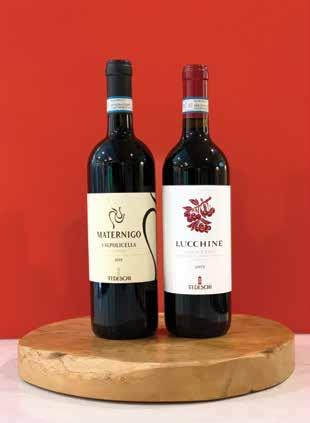
4 minute read
Grapes With Altitude
By Mike Muirhead, Sommelier (ISG), CMS
High-altitude vineyards are not an innovation in wine. Mountainous regions like Alto Adige in Italy and Ribera del Duero in Spain have been producing wines for centuries. However, in the last 20 years, there has been a significant drive up the hill and to new heights in New
World countries such as Argentina and Chile. These wine regions have, in return, brought significant attention to high-altitude wines. So what do these dizzying heights mean for grapes and grape growing? Let’s look at the factors that make high-altitude wines different.
Sunlight
The first time I went skiing in the Rockies, I was surprised when I took off my goggles and saw my reverse raccoon eyes. How could I get a sunburn in the middle of winter at -15°C? The answer is sunlight intensity. The higher the altitude, the more intense the sun’s rays (and, in particular, UV-B light). This intense light has a dramatic effect on grapes, creating thicker skins to protect the berry against the harsher sunlight. Thicker skin contains more colour pigment and tannins, which produces vibrant dark wines with the ability to age.
Intense sunlight gives MALBEC its signature colour.

Temperature
Altitude is a great moderator of temperature. As wine regions struggle with climate change heating up their vineyards, one of the answers is to move up the hills. Temperature variation comes in two forms: the first is that the higher you go, the lower the average temperature is. Most grapes benefit from a long growing season, and as global temperatures increase, harvest at lower elevations is happening earlier and earlier in the year. In addition, much larger day-to-night (diurnal) temperature variations at higher altitudes mean that the grapes stop ripening during the evening, allowing the berries to maintain higher acidity compared to their lower-altitude counterparts. This “freshness” that comes with wines of altitude adds to a wine’s balance and complexity, also lending longevity to the final product.

Greater shifts in daytime and nighttime temperature (called diurnal shifts) accentuate SAUVIGNON BLANC’s signature racy acidity.

Soil
On a trip to Chile 15 years ago, winemakers we met from the best estates were eager to show us how they were moving “up the hillsides” in an effort to create better wine. Planting grapes on the valley floor meant that vines could be easily harvested by machine, the grapes had plenty of access to water, and they grew in the rich valley floor soil. There is an inverse rule with grapes, however: the more the vine struggles, the better the quality of grapes. Steep, rocky slopes mean that water drainage is quick, and the vine focuses its efforts on deep-soil roots to seek out hard-tofind water and minerals. A lower-yielding plant puts more effort into fewer berries, and this equates to more complex and concentrated fruit.
When grown on steep slopes with rocky soils, CHARDONNAY shows minerality and heightened complexity.
Same Grape, With Altitude
To fully demonstrate how altitude affects wine and winemaking styles, we turn to one of the leaders in high-altitude wine research: Argentina. Malbec has found a unique home in the region, and the wines are significantly different from the styles of their ancestral home of Cahors, France (alt: 219 m). We compared two wines that use similar winemaking styles to truly focus our comparison on the difference altitude makes.
Pulenta I Malbec (Mendoza, $36.99): Before the foothills of the Andes, you will find beautiful, rolling plains; however, in this case, those rolling hills just happen to rise to 1,200 m above sea level. The Pulenta I is a textbook high-altitude Malbec: it is a deep, dark red in the glass with black fruit, dark chocolate, and spice box on the nose. On the palate, it is heady, warming, and rich, with chalky tannins that fill the mouth.
Amalaya Territorio Malbec (Salta Province, $22.99): Move up 500 m and you will reach the dizzying heights of Territorio at 1,700 m. While this wine still has the trademark dense black colour, the nose hints at something different. Over the dark berry fruit, there is a layer of floral and slate on the nose. On the palate, there is a freshness that makes the wine mouthwatering and savoury—a quick peek at the alcohol also shows 1% less than the lower-altitude Malbec, and the palate is harmonious and inky.

Same Blend, New Heights
In some cases, the vineyard’s altitude can dictate the style of wine that is created. For this example, we looked at the same producer creating a Valpolicella blend. The first is a wine created from lower, rolling hills; the second wine, grown in a single vineyard on steep slopes 300 m higher up, simply could not produce its special attributes at a lower altitude.
Tedeschi Lucchine Valpolicella Classico (Veneto, $21.99): This red is a great example of entry-level Valpolicella—a classic blend of Corvina, Corvinone, Rondinella, and Molinara. It is a bright ruby red, and the nose shows fruit salad, red cherry, and cranberry. On the palate, it is light and refreshing—a wine that should be enjoyed young and slightly chilled.
Tedeschi Maternigo Valpolicella Superiore (Valpolicella, $43.99): Following a similar blend of Corvina, Corvinone, and Rondinella, the difference is seen in the depth of colour. A darker garnet in the glass comes with more extraction; the aromas of cherries and cranberry remain but are joined by plums, figs, and a layer of mineral and herbal notes. On the palate, it is quite complex and layered with dusty tannins and a long, elegant finish. It’s hard to believe these are the same grapes from the same producer.

High Altitude
The term “high altitude” is relative in each region—some grapes experience high-altitude conditions a few hundred metres above sea level, and some grow up the slopes of the great Andes. It is the conditions of sunlight, diurnal temperature, and soil that produce wines of great complexity. See below for an idea of the relative high and low altitudes in some of the world’s most renowned regions.
highest altitudes at which vines are grown lower-altitude vineyards







